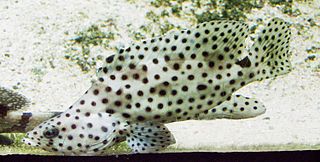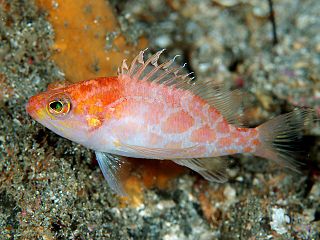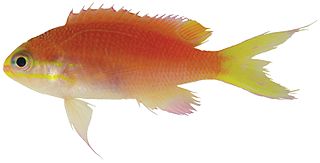
The Serranidae are a large family of fishes belonging to the order Perciformes. The family contains about 450 species in 65 genera, including the sea basses and the groupers. Although many species are small, in some cases less than 10 cm (3.9 in), the giant grouper is one of the largest bony fishes in the world, growing to 2.7 m in length and 400 kg (880 lb) in weight. Representatives of this group live in tropical and subtropical seas worldwide.

Groupers are fish of any of a number of genera in the subfamily Epinephelinae of the family Serranidae, in the order Perciformes.

Plectranthias is a genus of ray-finned fish in the subfamily Anthiinae, part of the family Serranidae, the groupers and sea basses. They are found in the Atlantic, Indian and Pacific Ocean.

Cephalopholis is a genus of marine ray-finned fish, groupers from the subfamily Epinephelinae in the family Serranidae, which also includes the anthias and sea basses. Many of the species have the word "hind" as part of their common name in English.

Plectropomus, commonly known as the coral groupers, is a genus of marine ray-finned fish, groupers from the subfamily Epinephelinae, part of the family Serranidae, which also includes the anthias and sea basses. They are found in the Indo-Pacific region.

Pseudanthias is a genus of colourful reef fishes of the subfamily Anthiinae, part of the family Serranidae, the groupers and sea basses. They are found in the Indo-Pacific. The species belonging to this genus have a diet consisting of zooplankton, and are haremic. Fishes currently included in this genus were earlier part of the genus Anthias. Pseudanthias is the largest anthiine genus

Halichoeres are a genus of wrasses found in the Atlantic, Indian and Pacific Oceans.

Variola, the lyretails, is a genus of marine ray-finned fish, groupers from the subfamily Epinephelinae, part of the family Serranidae, which also includes the anthias and sea basses. They are found in the tropical Indo-Pacific and their distribution extends from the Red Sea to South Africa across the Indian Ocean and east to the islands of the central Pacific.

Liopropoma rubre, the peppermint bass or swissguard basslet, is a species of marine ray-finned fish, related to the groupers and classified within the subfamily Epinephelinae of the family Serranidae. It is found in the western Atlantic Ocean. This species is utilised in the aquarium trade.

The roving coral grouper, also known as the spotted coral grouper, is a species of marine ray-finned fish, a grouper from the subfamily Epinephelinae which is part of the family Serranidae, which also includes the anthias and sea basses. It is found in the Indo-Pacific, although the Red Sea taxon, P. marisrubri, is regarded as a separate species by some authorities.

Hyporthodus is a genus of marine ray-finned fish, groupers from the subfamily Epinephelinae, part of the family Serranidae, which also includes the anthias and sea basses. It contains the following species, most of which were previously placed in Epinephelus:
Liopropoma carmabi, the candy basslet, is a species of fish in the family Serranidae.

Liopropoma santi, the spot-tail golden bass, is a species of marine ray-finned fish, related to the groupers and classified within the subfamily Epinephelinae of the family Serranidae. It has been collected from deep reefs off Curaçao, southern Caribbean; it is the deepest occurring Liopropoma species in the Atlantic Ocean.

Pseudogramma is a genus of marine ray-finned fish, related to the groupers and classified within the subfamily Epinephelinae of the family Serranidae. They live on coral reefs and exhibit cryptic colors and patterns to conceal them. They are mainly found in the Indo-Pacific with one species in the eastern central Atlantic Ocean.

The masked grouper, also known as the thinspine grouper, rededged cod, red-edged grouper, slenderspine grouper, thinspine rockcod, white-margined grouper, white-square cod or white-square grouper, is a species of marine ray-finned fish, a grouper from the subfamily Epinephelinae which is part of the family Serranidae, which also includes the anthias and sea basses. It is found in the western Atlantic Ocean. It is the only species in the genus Gracila.

Tosanoides is a genus of marine ray-finned fish in the subfamily Anthiinae which is part of the family Serranidae, the groupers and sea basses. They are found in the Atlantic and Pacific Ocean.

Tosanoides obama, Obama's basslet, is a coral reef fish species from the subfamily Anthiinae part of the family Serranidae, the groupers and sea basses. It was discovered in Papahānaumokuākea Marine National Monument, Hawaii. Tosanoides obama was named after former US President Barack Obama in honor of his efforts to preserve natural environments including expanding the Papahānaumokuākea Marine National Monument. It was first discovered and described by Richard Pyle, Brian Greene and Randall Kosaki in December 2016. They also noted a distinctive spot on the male's dorsal fin reminiscent of Obama's campaign logo. The fish live in small groups in holes in reefs at a depth of around 90 m. Following the discovery the size of the reserve was increased.
Liopropoma emanueli, the Cape Verde basslet, is a species of marine ray-finned fish, related to the groupers and classified within the subfamily Epinephelinae of the family Serranidae. It is endemic to the Atlantic waters around Cape Verde, western Africa where it is found in rocky areas at depths of 20 to 36 metres. Its length is 10 to 12 cm.

Bathyanthias is a genus of marine ray-finned fish, related to the groupers and included in the subfamily Epinephelinae, part of the family Serranidae, which also includes the anthias and sea basses. They are found in the Western Atlantic Ocean.
Jeboehlkia is a monotypic genus of marine ray-finned fish, related to the groupers and classified within the subfamily Epinephelinae of the family Serranidae. It is a species of relatively deep water which is found in the western Atlantic Ocean. The only species in the genus is Jeboehlkia gladifer, the bladefin bass.

















